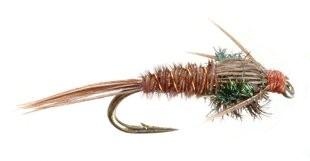
On The Fly
"Fly tying is a school from which we never graduate"
 PATTERN OF THE MONTH - American Pheasant Tail Nymph
PATTERN OF THE MONTH - American Pheasant Tail Nymph
Hook: Daiichi 1550 or equivalent standard nymph hook, size 14-22.
Thread: Brown 6/0, 8/0 on smaller sizes.
Tail: Pheasant tail fibers.
Abdomen: Butts of tail fibers.
Rib: Copper wire.
Wing case: Pheasant tail fibers.
Thorax: Peacock Herl.
Legs: Tips of wing case fibers.
Head: Brown thread.
Tying Instructions:
1) Start the thread one eye width back from the eye. Lay down a thread layer covering the shank to just
above the barb.
2) Select three or four barbs from the center tail of a ring-necked pheasant. Align the tips of the barbs
and set the length of the barbs to match the length of the hook shank and tie them in just above the barb
of the hook to form the tail. Advance the thread forward binding down the fibers on the top of the shank
covering the back 2/3. Next, pull the fibers back over the shank towards the rear, and then wrap the thread
rearward to bind down the fibers, using close wraps of thread, to the tail tie-in position.
3) Tie in the copper wire at the base of the tail and advance the thread, in three spiral wraps, to the
2/3 position. Let the thread hang.
4) Wrap the butts of the tail fibers forward to cover the rear 2/3 of the shank. Tie off the fibers and
clip the excess material.
5) Select six fibers from the same pheasant tail feather, align the fiber tips and set the length of the
fibers to match the length of the hook shank. Tie in the butt-ends of the fibers behind the eye with the
tips of the fibers protruding over the eye of the hook. Wrap the thread rearward over the butts and to the
front of the abdomen. The butts will become the wing case.
6) Select two or three peacock herl fibers, twist them into the thread and wind them forward to one
eye-width behind the eye. Tie off and trim.
7) Counterwind the copper wire forward in five evenly spaced turns: three on the abdomen and two through
the thorax. Tie off and trim.
8) Pull the wing case fibers over the top of the thorax. Tie off and trim. Leave room for the head.
9) Separate three fibers (far-side legs) and pull them along the far side; take one wrap of thread and
adjust the fibers. Gather three fibers (near-side legs) and pull them along the near side; take one wrap
of thread and adjust the fibers. When you are satisfied with the leg positions take a tight wrap of thread
to lock the legs in place.
10) Form a neat thread head. Whip-finish the thread and apply cement.
The original Pheasant Tail Nymph was developed by Frank Sawyer, riverkeeper on Brtitain's Avon. The pattern was modified by Montana's Al Troth to include the deadly peacock herl. My research tells me that the Pheasant Tail Nymph is an excellent choice for winter trout fishing in western streams. The size can be varied to imitate any natural hatch. A flash back can be added to the wing case for lake fishing. A bead head can be incorporated for going deep.
TYING TIPS
Just remember to reinforce the effective, but fragile peacock herl, by twisting it around
the thread before winding it. By counterwrapping the copper wire through the peacock herl you provide extra
strength. So, tie some up, brave the elements and give them a test flight. Let me know how you do.
Tie One On,
Dan Kellogg (you can contact me at FLYGUY@EZNORTHWEST.COM)